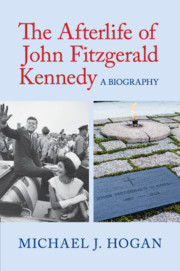Book contents
- Frontmatter
- Dedication
- Contents
- Acknowledgments
- List of Abbreviations
- 1 The Afterlife of John Fitzgerald Kennedy: An Introduction
- 2 All the World's a Stage: Constructing Kennedy
- 3 From History to Memory: Assassination and the Making of a Sacred Symbol
- 4 Ritual and Remembrance: Cultural Trauma, Collective Memory, and the Funeral of John Fitzgerald Kennedy
- 5 In Death There Is Life: Monuments of Paper and Pen
- 6 In Death There Is Life: Monuments of Glass, Steel, and Stone
- 7 The Memory Wars: Contesting Kennedy
- 8 Gone but Not Forgotten: History, Memory, and Nostalgia
- Notes
- Selected Bibliography
- Index
5 - In Death There Is Life: Monuments of Paper and Pen
Published online by Cambridge University Press: 23 March 2017
- Frontmatter
- Dedication
- Contents
- Acknowledgments
- List of Abbreviations
- 1 The Afterlife of John Fitzgerald Kennedy: An Introduction
- 2 All the World's a Stage: Constructing Kennedy
- 3 From History to Memory: Assassination and the Making of a Sacred Symbol
- 4 Ritual and Remembrance: Cultural Trauma, Collective Memory, and the Funeral of John Fitzgerald Kennedy
- 5 In Death There Is Life: Monuments of Paper and Pen
- 6 In Death There Is Life: Monuments of Glass, Steel, and Stone
- 7 The Memory Wars: Contesting Kennedy
- 8 Gone but Not Forgotten: History, Memory, and Nostalgia
- Notes
- Selected Bibliography
- Index
Summary
As we have seen, President Kennedy's assassination and funeral marked a period of acute cultural trauma notable not only for its widespread feelings of grief, shock, and insecurity but also for its many “flashbulb” memories – of a child's adoring salute to his father, of a daughter's loving embrace of his casket, of a widow's strength and courage, of the eternal flame. For those on hand, not to mention the millions watching on television, these individual memories quickly folded into a collective memory that would last a lifetime. In this sense, the president's funeral served not only to calm a nervous nation, or even to burnish further the idealized image of the president and first lady as both had performed their parts on the White House stage. It also served as a frame of reference through which so many Americans would remember John F. Kennedy in the years following his tragic death.
Memories of the late president would quickly take on a sacred quality; his character would be ennobled and his virtues celebrated as those at the heart of the nation's identity. Here was the president as hero, the larger-than-life figure who was one of us, as Arthur G. Neal put it, but also the best of us. Here was the ideal American president, the man of charm and good humor, the optimistic and confident leader who inspired hope in the American people and the conviction that they could do anything. Here was the devoted husband and loving father, the tolerant and pragmatic idealist, the seeker of peace through security, the champion of social justice and human rights. Here was the decorated navy veteran who had given his life in service to the nation and from whose death would spring a new birth of American democracy.
This basically conventional narrative of national redemption through the blood sacrifice of a fallen leader became, for the Kennedy family and most Americans, the approved story of the president's life.
- Type
- Chapter
- Information
- The Afterlife of John Fitzgerald KennedyA Biography, pp. 101 - 127Publisher: Cambridge University PressPrint publication year: 2017



